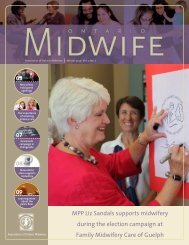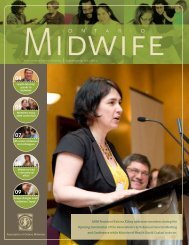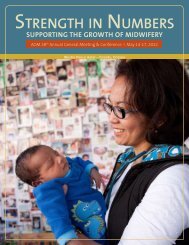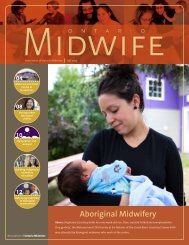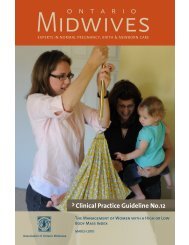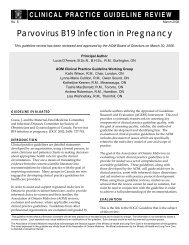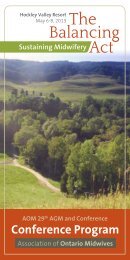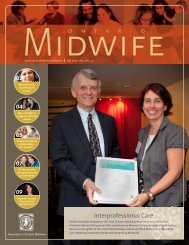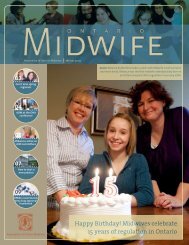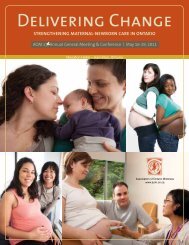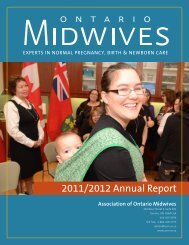Fall 2009 - Association of Ontario Midwives
Fall 2009 - Association of Ontario Midwives
Fall 2009 - Association of Ontario Midwives
You also want an ePaper? Increase the reach of your titles
YUMPU automatically turns print PDFs into web optimized ePapers that Google loves.
H1N1: Creating a plan foryour practiceMembers will notice frequent updatessent to practices regarding preventionand treatment <strong>of</strong> the H1N1 flu virus.The AOM and other health careprovider organizations meet withthe Ministry <strong>of</strong> Health’s EmergencyPlanning Team regularly to receiveup-to-date information about pandemicplanning, prevention and treatment.The information is then disseminated topractices by e-mail and fax. The AOM alsocreated a special section about H1N1 inthe members only portion <strong>of</strong> the website.In addition, the AOM recently developedand distributed a checklist to assistpractices in developing their ownpandemic plan. It is included in the IRMPBulletin #12, available for download inthe members only section <strong>of</strong> the AOMwebsite.Each practice will have different needsaccording to their own community andpractice situation. The checklist canhelp guide a planning discussion aroundseveral topics including:• General Knowledge for Caring forClients with Respiratory Symptoms• Caring for Women Who are Ill• Role Clarity• Key Services• Supplies• Services and Human Resources• Security• Data Systems, Client Appointments• Planning for Unexpected Costs<strong>Ontario</strong> Midwife interviewed RemiEjiwunmi , RM, chair <strong>of</strong> the Insurance andRisk Management Program Committee,about how H1N1 is affecting herpractice and clients.What is the most important thingmidwives should know about H1N1?<strong>Midwives</strong> need to know how to protectthemselves, their clients and those incontact with their clients from risk <strong>of</strong>transmission.What, if anything, has your practice doneto prepare for the possibility <strong>of</strong> a flupandemic?We reviewed the risks <strong>of</strong> transmissionand the criteria for risk assessment, forexample how and when to screen andwhat to do in response to elevated risks.We ensured our practice has adequatesupplies <strong>of</strong> barrier protection like goggles,face masks and gowns, and made sure wehad enough hand washing stations andalcohol-based pumps. We changed theanswering machine message to indicateto clients the need for risk screening andput up signs around the <strong>of</strong>fice to thesame effect. Our practice has also talkedabout what we would do if midwivesare compromised by illness, and howto manage limitations in staffing dueto potential hospital restrictions if anoutbreak takes place.How did you organize the work in yourpractice?Because we are a larger practice, weassigned roles and responsibilities to asmaller subcommittee. Any practice candecide what’s most important for themand work until they have a full plan.Is getting prepared for H1N1 just like itwas for SARS six years ago? What did thatexperience teach midwives?I’d say there are similarities. <strong>Midwives</strong>really understand the importance <strong>of</strong>being constantly up to date on recommendationsabout risk assessment andminimizing transmission. And, like duringSARS, we know it’s important to have acoordinated practice strategy for makingsure we know what other parties require<strong>of</strong> us, like our hospitals, and the Ministry<strong>of</strong> Health and Long-Term Care.How are clients responding to informationand media stories about H1N1?My experience has been that clients arenot panicked. Generally, clients have hadsome questions about vaccination andantivirals, but this has not dominated ourdiscussions.Emergency Infection Control Kits available for midwivesIn 2006, after the SARS epidemic, theMinistry <strong>of</strong> Health and Long-Term Caresent an Emergency Infection Control Kit(EICK) to each midwife and physician inthe province. These kits include surgicalmasks, gloves, gowns, goggles, surfacesanitizer and hand gel sanitizer.All practitioners who did not receive thekit in 2006 are invited to contact theMinistry to request that a kit be sentto them. Practices may wish to requestenough EICKs so that each midwife inthe practice group will have one in theevent that supplies become short duringa pandemic. New kits are not availableto practitioners who received one threeyears ago.To request a kit, simply send a messagewith your name and clinic addressindicating that you are a midwife whodid not receive a kit in 2006. Send themessage to emergencyICkits@moh.gov.on.ca.With regards to the kits from 2006, thehand sanitizer and the surface sanitizerare likely past their “best before” dates.However, the Ministry is not replacingthose items. It remains the responsibility<strong>of</strong> individual practitioners to besure that clinics have sufficient supplieson hand.Do not hesitate to send your questionsto the AOM at:riskmanagement@aom.on.ca, or call1-866-418-3773.www.aom.on.ca05




